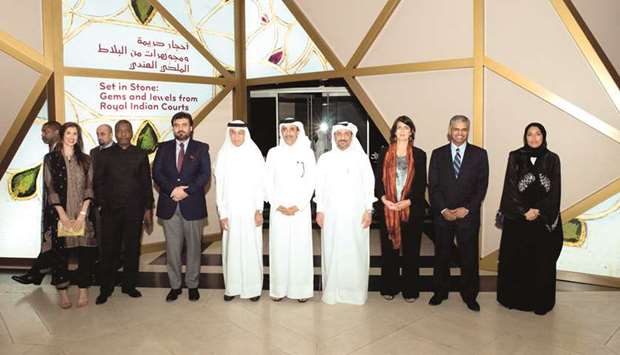HE the Minister of Culture and Sports Salah bin Ghanem bin Nasser al-Ali led the opening of the Set in Stone: Gems and Jewels from Royal Indian Courts exhibition at the Museum of Islamic Art (MIA) yesterday.
The exhibition features more than 100 pieces of magnificent gems and jewellery from India, which also forms part of Qatar Museums (QM)’s various collections, including several masterpieces that have never been displayed before.
“We are delighted to celebrate the opening of this extraordinary exhibition, developed as part of the Qatar-India Year of Culture. It allows us to present examples of the most spectacular pieces in the MIA, along with important artworks and objects from other QM collections,” MIA director Dr Julia Gonnella said in a press statement.
The exhibition’s fourth section, titled Qatar Connection, Pearls for Gold, recounts the long cultural and commercial exchanges between India and Qatar, as seen through the traditions of pearls and gold, and explores how this lineage has influenced local Qatari jewellery fashion.
Drawing from the MIA’s permanent collection, the National Museum of Qatar (NMoQ), and the QM’s Orientalist Collection, this exhibition brings together a splendid array of jewellery, jewelled objects, works on paper, as well as photography.
The exhibition’s first section, Precious Stones, reveals the cultural and economic importance of stones in India, tracing their history, sourcing, and trade in the early modern period, while the Court & Ceremony section explores the role that gems, jewellery and jewelled objects played within a courtly context in the outward projection of wealth and status.
The third section, Beyond the Court, shows the personal, private and devotional uses of crafted jewels.
Some of the exhibition highlights include “Indian-Cut” diamonds from the famed mines of Golconda, in the Deccan (southern India), which – until the discovery of new diamond deposits in the 18th century – were the main source of diamonds throughout the world.
The MIA’s jewelled falcon, which most likely adorned the top of a throne, is a masterpiece of 17th century Mughal craftsmanship and demonstrates the richness of the Mughal court.
The necklace from Varanasi: composed of 17 diamonds suspended with gold-collared emeralds surmounted by baroque pearls, is also on spotlight, showcasing the continued opulence of 19th century Maharajas.
According to the MIA, the most impressive object on display is known as the “Clive flask”, a 17th century jewel-encrusted jade flask that once belonged to Robert Clive, 1st Baron Clive of Plassey (1725-1774).
This object – remarkable for both its beauty and provenance – will be displayed in Doha for the first time.
The MIA noted that for over 5,000 years, minerals and metals were extracted from India’s rich earth and crafted into beautiful pieces as ornaments or gifts.
Many travellers and traders have been attracted by India’s reputation for its abundantly rich natural deposits for centuries – “so prized were these stones that wars were waged to win the right to exploit mines and control trade routes”.
According to the MIA, the wealth of any Indian court was directly tied to the size and value of its royal treasury, and nowhere was this clearer than in the Mughal Empire (1526-1858).
Whether left in their natural state, carved, or set within gold, precious stones adorned a variety of objects that came to be associated with the wealthy elite, emperors and maharajas.
Spectacularly opulent, these objects defined Indian luxury, the MIA noted.
The exhibition is curated by Dr Tara Desjardins, with the support of Nicoletta Fazio, Reem Aboughazala, and Tamadur Tariq al-Shamlan.
It will be open until January 18, 2020.

HE the Minister of Culture and Sports Salah bin Ghanem bin Nasser al-Ali with other dignitaries at the opening of the *Set in Stone: Gems and Jewels from Royal Indian Courts exhibition at the MIA yesterday.

